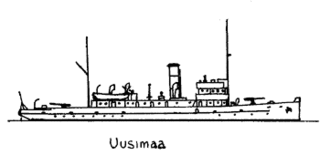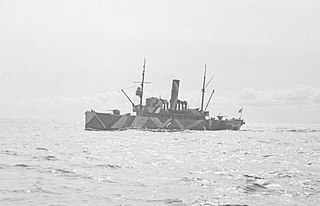
The Finnish Navy is one of the branches of the Finnish Defence Forces. The navy employs 2,300 people and about 4,300 conscripts are trained each year. Finnish Navy vessels are given the ship prefix "FNS", short for "Finnish Navy ship", but this is not used in Finnish-language contexts. The Finnish Navy also includes coastal forces and coastal artillery.
Vesikko is a submarine, which was launched on 10 May 1933 at the Crichton-Vulcan dock in Turku. Until 1936 it was named by its yard number CV 707. Vesikko was ordered by a Dutch engineering company Ingenieurskantoor voor Scheepsbouw in 1930 as a commercial submarine prototype, being the prototype for the German Type II submarines. Purchased by the Finnish before World War II, she saw service in the Winter War and Continuation War, sinking the Soviet merchant ship Vyborg as her only victory. After the cease-fire with the Allies in 1944, Vesikko was retired. Finland was banned from operating submarines after the war and she was kept in storage until she was turned into a museum ship.

The Baltic Sea campaigns were conducted by Axis and Allied naval forces in the Baltic Sea, the Gulf of Bothnia, the Gulf of Finland and the connected lakes Ladoga and Onega on the Eastern Front of World War II. After early fighting between Polish and German forces, the main combatants were the Kriegsmarine and the Soviet Navy, with Finland supporting the Germans until 1944 and the Soviets thereafter. The Swedish Navy and merchant fleet played important roles, and the British Royal Navy planned Operation Catherine for control of the Baltic Sea and its exit choke point into the North Sea.

Vesihiisi was a Finnish 500-tonne Vetehinen-class submarine that was constructed in the early 1930s. The vessel served in the Finnish Navy during the second World War.

Vetehinen was a 500-tonne Vetehinen-class submarine that was constructed in the early 1930s, which served in the Finnish Navy during the Second World War. The submarine was the first ship of its class of three submarines. The name vetehinen means "merman".

Iku-Turso was a 500-tonne Vetehinen-class submarine that served in the Finnish Navy during the Second World War. It was launched in May 1931 and was named after a mythological Finnish sea monster, Iku-Turso. It was built by the Crichton-Vulcan shipyard in Turku according to a project developed by NV Ingenieurskantoor voor Scheepsbouw, "IvS", and was scrapped in 1953.

Saukko (Pu110) was a small submarine that served in the Finnish Navy during the Second World War. It was designed not to exceed 100 tonnes, as it was planned for use in Lake Ladoga, and according to the 1920 Treaty of Tartu, no nation was allowed to use naval ships of more than 100 tonnes on the lake. The submarine could be divided into separate sections and transported by rail. The conning tower could be lifted off entirely. The engines were in the aft section and the batteries in the forward section. The name "Saukko" means European otter.

Turunmaa was a Finnish gunboat built in 1918. She served in the Finnish Navy during World War II. The ship was named after Turuma, a type of frigate designed for use in shallow waters of the archipelago and served in the Swedish Archipelago fleet in the late 18th century. The frigates had in turn been named after the region of Finland.

Karjala (ex-Filin) was a Finnish gunboat, built in 1918 at Ab Crichton shipyard in Turku. She served in the Finnish Navy during World War II. Karjala was named after the Finnic cultural region of Karelia. Like her sister ship Turunmaa, she served as cadet training vessel during peacetime and was nicknamed as Kurjala by cadets.

Uusimaa was a gunboat that served in the Finnish Navy during World War II. She was built in 1917. As the ship had changed hands many times during the turbulent last years of World War I she had been renamed many times: In Russian service, she was called Golub, later, in German service, her name was Beo. Finally the Germans handed her over to the Finns in 1920, who renamed her Uusimaa. After World War II, she served as a trawler in the Baltic Sea. She was scrapped in 1953.
The Syöksy-class motor torpedo boats was a series of four British Thornycroft type motor torpedo boats of the Finnish Navy. The vessels were constructed in 1928 by the John Thornycroft & Co. shipyard in Woolton, UK. The vessels saw service in World War II. The Thornycroft type released its torpedoes by dropping them from rails in the aft. The ship then had to steer away from the torpedoes path, a manoeuvre that could be quite tricky in the close waters of the Gulf of Finland.

The Soviet evacuation of Tallinn, also called Juminda mine battle, Tallinn disaster or Russian Dunkirk, was a Soviet operation to evacuate the 190 ships of the Baltic Fleet, units of the Red Army, and pro-Soviet civilians from the fleet's encircled main base of Tallinn in Soviet-occupied Estonia during August 1941. Near Juminda peninsula Soviet fleet ran into minefield that had been laid by the Finnish and German navies, and were repeatedly attacked by aircraft and torpedo boats, incurring major losses.

The Battle of Someri took place in the Gulf of Finland during World War II on 8–9 July 1942, between the Soviet Union and Finland. Starting as a modest operation to clear a Finnish observation post from a small island, it became one of the largest surface ship engagements in the Baltic theater.

Riilahti was a Ruotsinsalmi class minelayer of the Finnish Navy. Riilahti was commissioned in 1940 and sunk in 1943. The vessel was named after the battle of Riilahti, which was fought between Sweden and Russia in 1714.

The Ruotsinsalmi-class minelayers were a two-strong class of minelayers in the Finnish Navy. The two ships, comprising Ruotsinsalmi and Riilahti, were constructed in Finland and saw service in the Winter War and World War II. Riihahti was sunk in an engagement with Soviet motor torpedo boats on 23 August 1943. Ruotsinsalmi survived the wars and remained in service in the post war Finnish Navy until being withdrawn in the 1970s.

Louhi was a Finnish Navy minelayer. The ship was originally constructed for the Imperial Russian Navy but was taken over by the Finns during the Russian Civil War. She had originally been named Voin, but was renamed as M1 in Finnish service. In 1936 she was given the more personal name Louhi, following the procedure of all other major ships in the Finnish navy.
The Romanian Navy during World War II was the main Axis naval force in the Black Sea campaigns and fought against the Soviet Union's Black Sea Fleet from 1941 to 1944. Operations consisted mainly of mine warfare, but there were also escort missions and localized naval engagements. The largest naval action fought by the Romanian Navy was the 26 June 1941 Raid on Constanța, and its most extensive operation was the 1944 evacuation of the Crimea.

The Soviet Navy launched the Soviet submarine Baltic Sea campaign in 1942 to harass the strategic iron-ore traffic from neutral Sweden to Nazi Germany during World War II. The Soviet Union and the German Reich fought each other on the Eastern Front (1941-1945) during the war. The Allies also launched other operations - especially involving the Royal Navy - against the traffic.

The Soviet submarine Baltic Sea campaign in 1943 was launched by the Soviet Navy to harass the strategic iron ore traffic from neutral Sweden to Nazi Germany on the Eastern Front during the WWII. Other operations were launched by Allies, especially by the Royal Navy. The offensive was a repetition of the previous campaign in 1942 but resulted in a failed outcome.
















